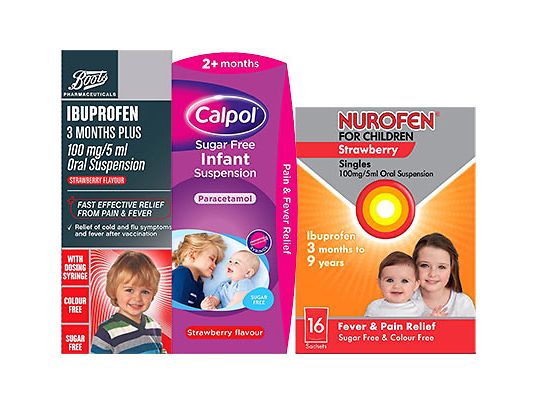
Taking Paracetamol and Ibuprofen
Ibuprofen and Paracetamol can both provide fast and effective relief from fever and pain, but it’s crucial to get the doses right.
We’re all familiar with paracetamol and Ibuprofen, but people are often uncertain about the differences between them and when each should be taken. Our guide has everything you need to know.
It is normally better to give paracetamol (which trades under Calpol for children) first in order to reduce a fever. You can take it every four to six hours, but the maximum dose for any 24-hour period should be four.
Ibuprofen comes into play if your child still needs additional medication. It works by blocking prostaglandins which are released by the body as a response to illness or injury. These can cause pain, swelling, inflammation and sometimes fever. By blocking these, Ibuprofen can quickly alleviate pain and fever.
If the fever or pain is persistent, you may alternate your doses between the two giving one or the other every four hours. That way you will avoid exceeding the dose for either. However, you should never take both at the same time.
With both it is crucial to ensure you observe the correct doses depending on the child’s age. Below we’ve listed the appropriate dose levels you should be following.
Paracetamol (common trade name: Calpol)
-
- Babies aged two months (usually given with the eight-week vaccines): 60mg (2.5mls of the preparation that contains 120mg per 5 mls), given every 4-6 hours; maximum 4 doses per 24 hours. Maximum total daily dose 60mg/kg body weight.
- Infants aged 3-5 months: 60mg every 4-6 hours; maximum 4 doses per 24 hours.
- Infants aged 6-12 months: 60mg (or up to 15mg/kg body weight) every 4-6 hours; maximum 4 doses per 24 hours.
- Children aged 12-24 months: 120 mg (or up to 15mg/kg body weight) every 4-6 hours; maximum 4 doses per 24 hours.
- Children aged 2-3 years: 180mg (or up to 15mg/kg body weight) every 4-6 hours; maximum 4 doses per 24 hours.
- Children aged 4-5 years: 240mg (or up to 15mg/kg body weight) every 4-6 hours; maximum 4 doses per 24 hours.
- Children aged 6-7 years: 240-250mg (or up to 15mg/kg body weight) every 4-6 hours; maximum 4 doses per 24 hours.
- Children aged 8-9 years: 360-375mg (or up to 15mg/kg body weight) every 4-6 hours; maximum 4 doses per 24 hours.
- Children aged 10-11 years: 480-500mg (or up to 15mg/kg body weight) every 4-6 hours; maximum 4 doses per 24 hours (maximum 4 grams per 24 hours).
- Children aged 12-15 years: 480-750mg (or up to 15mg/kg body weight) every 4-6 hours; maximum 4 doses per 24 hours (maximum 4 grams per 24 hours).
- Children aged 16-17 years: 5 gram – 1.0 gram (maximum 4 grams per 24 hours).
IBUPROFEN (common trade name: Nurofen)
-
- Children aged 3-5 months: 50mg 8 hourly (maximum daily dose 30mg/kg body weight per 24 hours).
- Children aged 6-11 months: 50mg 8 hourly (maximum daily dose 30mg/kg body weight per 24 hours).
- Children aged 1-3 years: 100mg 8 hourly (maximum daily dose 30mg/kg body weight per 24 hours).
- Children aged 4-6 years: 150mg 8 hourly (maximum daily dose 30mg/kg body weight per 24 hours).
- Children aged 7–9 years: 200 mg 8 hourly (maximum daily dose 30 mg/kg body weight per 24 hours). Maximum 2.4 g per 24 hours.
- Children aged 10–11 years: 300 mg every 8 hours (maximum daily dose 30 mg/kg body weight per 24 hours). Maximum 2.4 g per 24 hours.
- Children aged 12–17 years: Initially 300–400 mg 3–4 times a day; increased if necessary, up to 600 mg 4 times a day; maintenance 200–400 mg 3 times a day, may be adequate.

